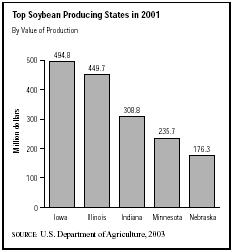SIC 2075
SOYBEAN OIL MILLS
This category covers establishments primarily engaged in manufacturing soybean oil, cake, and meal, and soybean protein isolates and concentrates, or in processing purchased soybean oil into forms other than edible cooking oils. Businesses primarily engaged in refining soybean oil into edible cooking oils are classified in SIC 2079: Shortening, Table Oils, Margarine, and Other Edible Fats and Oils, Not Elsewhere Classified.
NAICS Code(s)
311222 (Soybean Processing)
311225 (Fats and Oils Refining and Blending)
Traditionally one of the largest U.S. crops, soybeans are especially valuable because the same automated presses yield two important products with closely linked markets—soybean oil and, representing more than 80 percent of the total, soybean meal. Unfavorable weather conditions hindered soybean production in the United States in both 2002 and 2003. As a result, the United States saw its share of global soybean production fall to a record low of 36 percent in 2003.
In the 1950s and 1960s, the largest food market for soybean meal was in meat processing, which used soy flour as a protein filler. This product eventually became outmoded as improved refining techniques yielded isolated soy proteins and concentrates having a wider range of applications and little or no independent flavor. These ingredients grew in popularity after legislation was passed that freed meat product manufacturers from regulations that insisted on prominent package labeling of the presence of such ingredients. In the 1970s and 1980s, increasing desirability of high-protein animal feeds, and soy's enhanced status as a healthy ingredient in food, led to increased demand for meal. Soybean meal and oil production volume increased proportionally.
Total U.S. production of soybeans totaled 2.89 billion bushels in 2001, compared to 2.38 billion bushels in 1996. This record U.S. soybean crop resulted in lower prices, as the farm price dropped from $4.54 per bushel in 2000 to $4.30 per bushel in 2001, compared to a high of $7.35 per bushel in 1996. When soybean production dipped to 2.72 billion bushels in 2002, due to poor weather conditions, prices increased to $5.40 per bushel. Domestic use of soybean oil increased considerably throughout the late 1990s and early 2000s, while many competing fats and oils experienced slow growth.
According to the U.S. Department of Agriculture, the price of soybean meal per short ton has fluctuated as well, from $162.60 in 1994, up to $270.90 in 1996, down to $138.55 in 1998, and back up to $173.59 in 2000. Soybean oil prices dropped consistently throughout the 1990s, from a high of $27.58 per pound in 1994 to $14.09 per pound in 2000.
The top five states, in terms of soybean production in 2002, were Iowa, Illinois, Minnesota, Indiana, and Nebraska. The number of soybeans crushed in 2001 reached

1.68 billion bushels, producing 18.1 billion pounds of soybean oil and 38 million tons of soybean cake and meal, according to the U.S. Department of Agriculture.
U.S. exports of soybeans and soybean meal—dominant in the global meal market—are expected to account for the bulk of the growth in world soybean output. In fact, in 2002, the United States accounted for 42 percent of the total world soybean output of 184.3 billion metric tons. Asia imports more than half of all U.S. soybean shipments. Europe is another strong market for U.S. exports.
The trend in the United States appeared to be in favor of greater acceptance and more widespread use of soybean products, especially in the form of isolated soy proteins and concentrates. Isolated soy proteins (ISPs) have been shown to equal the protein quality of milk and egg protein, to make logical substitutes for dairy protein because of their lack of fiber and 90 percent protein content, and to have uses in coffee creamers, protein-fortified beverages, weight-loss products and bodybuilding supplements, certain medical foods, and milk-free infant formulas.
According to the U.S. Census Bureau, more than 90 establishments are engaged in soybean oil processing. One leading company in the industry in 2004 was AG Processing Inc. of Omaha, Nebraska. The company is one of the largest soybean processors in the United States, with an average of 15,000 acres of soybeans processed each day. AG reported 2003 sales of $2.1 billion and 1,500 employees.
Another leader was Archer Daniels Midland Company of Decatur, Illinois. Nearly two-thirds of the company's sales come from oilseed products. Archer reported 2003 sales of $30.7 billion and 26,197 employees.
In the mid-1990s, there were significant technological advances in the production of biodiesel, a biodegradable, nontoxic, lower-emitting alternative to petroleum diesel fuel. Biodiesel is a fuel and edible oil blend for use in diesel engines and was expected to boost demand for soybean oil. The Chicago Biodiesel Plant, operated by Columbus Foods Company, which began production in 1997, was the first plant in the United States to produce biodiesel from combinations of used vegetable oils and fresh soybean oil, and it is expected to act as a model for future biodiesel production. In the late 1990s and early 2000s, AG Processing was also promoting its soybean oil-based biofuels.
Further Reading
"New Record for Global Oilseed Output in 2003-04," Agra Europe, 28 November 2003.
U.S. Department of Agriculture, National Agricultural Statistics Service. "Statistics of Oilseeds, Fats, and Oils." Washington, DC: 2003. Available from http://www.usda.gov/nass/pubs/agr03/03_ch3.pdf .
Comment about this article, ask questions, or add new information about this topic: